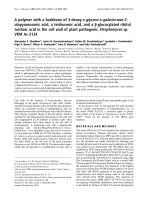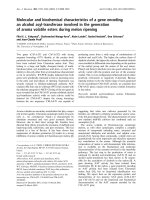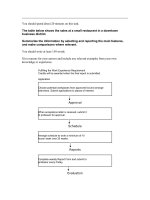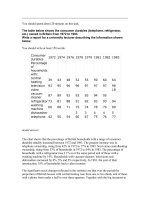Writing task 1
Bạn đang xem bản rút gọn của tài liệu. Xem và tải ngay bản đầy đủ của tài liệu tại đây (254.63 KB, 7 trang )
Band 9 Task 1
The graph shows changes in the gap between US energy consumption and
production since 1950. It also estimates trends up to 2025. Between 1950 and 1970
both production and consumption increased from just over 30 units to about 65, and
although consumption was consistently higher, the difference was marginal during
this period. However, production grew only gradually over the next 30 years to
reach 70 units in 2000. In contrast, growth in consumption was steeper and more
fluctuating, reaching 95 units by 2000. Energy imports needed to bridge this gap
therefore increased from very little in 1970 to a substantial 25 units in 2000.
Projections up to 2025 indicate that this trend is likely to continue, with the
gap between production and consumption widening. By 2025 it is expected that
consumption will reach 140 units, while production will reach only 90, so more than
30% of energy consumed (50 units) will have to be imported. Overall, the graph
indicated that energy production in the US is not keeping up with consumption, so
imports will continue to increase.
The diagram below shows the water cycle, which is the
continuous movement of water on, above and below the
surface of the Earth.
The picture illustrates the way in which water passes from ocean to air to
land during the natural process known as the water cycle.
Three main stages are shown on the diagram. Ocean water evaporates, falls
as rain, and eventually runs back into the oceans again.
Beginning at the evaporation stage, we can see that 80% of water vapour in
the air comes from the oceans. Heat from the sun causes water to evaporate, and
water vapour condenses to form clouds. At the second stage, labelled ‘precipitation’
on the diagram, water falls as rain or snow.
At the third stage in the cycle, rainwater may take various paths. Some of it
may fall into lakes or return to the oceans via ‘surface runoff’. Otherwise, rainwater
may filter through the ground, reaching the impervious layer of the earth. Salt water
intrusion is shown to take place just before groundwater passes into the oceans to
complete the cycle.
Graph Sample 1
The graph exhibits people using new music places on the internet in fifteen
days period of time namely personal choice and trendy pop music. The overall trend
shows fluctuation with slight increased towards the end of the period.
Staring with Music Choices websites; 40,000people went on this new site on
the first day. Half of them backed out the next day. In contrast to this pop parade net
sites were visited by 120,000 music lovers on the day one which decreased slightly
on the next day there after regaining the same fame on 3
rd
day.
After 3
rd
day the enthusiasm for both music lines on the internet dropped
slowly- reaching maximum fall of 40,000 on the 7
th
day. Whereas Music Choice
gained popularity, slightly improving to get the original strength of 30,000 viewers
on the screen, but was getting still less visitors then their opponent Pop group i.e.
40,000 on day 7.
In the beginning of the next week both gained remarkable recovery after few
fluctuations for 8
th
and 9
th
day having 40,000 and 50,000 visitors respectively,
reaching to their peaks of one and half thousand new visitors for Pop Parade on the
11
th
day showing the contrast of very few people visiting music capital choice for
the same day. Thereafter, Music Choice gained popularity on the 12 day for having
more than 120,000 new visitors on web.
In the end of the period Pop sites were visited by maximum viewers of
180,000 where as sides located to Music Choice were nor explored by more than
80,000 explorers on he last day of the report.
Graph Sample 2
The bar chart indicates a survey on two different age groups on the factors
contributing to make their environment pleasant for working.
These factors are divided in to internal and external factors. The internal
factors are the team spirit, competent boss, respect from colleagues and job









